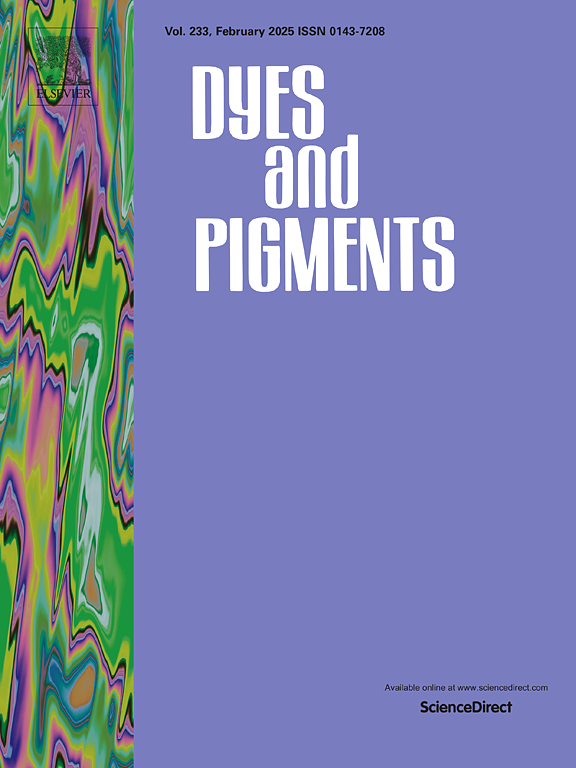Nitrogen-mediated dyeing of denim with natural indigo: Towards sustainable and efficient coloration
IF 4.1
3区 工程技术
Q2 CHEMISTRY, APPLIED
引用次数: 0
Abstract
The conventional indigo dyeing process for denim production poses significant environmental challenges. While natural indigo dyes offer eco-friendly alternatives, their application is limited by low dye uptake and poor color fastness. This study integrates molecular dynamics simulations and experimental approaches to explore the effects of nitrogen (N2) protected dyeing technology on natural indigo performance. Results reveal that N2 protection enhances the hydrogen bonding in cellulose fibers, strengthens dye-fiber interactions, and improves dye diffusion, leading to superior dyeing outcomes. Using response surface methodology (RSM), we identified N2 concentration and dyeing temperature as key factors influencing coloration efficiency and fastness. Under optimized conditions, natural indigo achieved performance comparable to synthetic dyes while exhibiting enhanced biodegradability in residual dye baths. Compared to conventional synthetic indigo dyeing processes, the N2-assisted natural indigo dyeing strategy achieves a 41.45 % reduction in chemical consumption, and 28.72 % decrease in energy consumption and CO2 emissions. These results validate its dual advantages in enhancing dye utilization efficiency and ecological sustainability. This work provides a theoretical foundation for sustainable denim dyeing and advances eco-conscious practices in textile industry, offering both scientific and practical insights.
氮介导天然靛蓝牛仔布染色:走向可持续和高效着色
牛仔布生产的传统靛蓝染色工艺对环境构成了重大挑战。虽然天然靛蓝染料提供了环保的替代品,但它们的应用受到染料吸收率低和色牢度差的限制。本研究结合分子动力学模拟和实验方法,探讨氮保护染色技术对天然靛蓝性能的影响。结果表明,N2保护增强了纤维素纤维中的氢键,增强了染料纤维的相互作用,改善了染料的扩散,从而取得了较好的染色效果。利用响应面法(RSM)确定了N2浓度和染色温度是影响染色效率和牢度的关键因素。在优化条件下,天然靛蓝达到了与合成染料相当的性能,同时在残留染料浴中表现出增强的生物降解性。与传统的合成靛蓝染色工艺相比,二氧化氮辅助的天然靛蓝染色策略可以减少41.45%的化学消耗,减少28.72%的能耗和二氧化碳排放。这些结果验证了其在提高染料利用效率和生态可持续性方面的双重优势。这项工作为可持续牛仔染色提供了理论基础,并推动了纺织工业的生态意识实践,提供了科学和实践的见解。
本文章由计算机程序翻译,如有差异,请以英文原文为准。
求助全文
约1分钟内获得全文
求助全文
来源期刊

Dyes and Pigments
工程技术-材料科学:纺织
CiteScore
8.20
自引率
13.30%
发文量
933
审稿时长
33 days
期刊介绍:
Dyes and Pigments covers the scientific and technical aspects of the chemistry and physics of dyes, pigments and their intermediates. Emphasis is placed on the properties of the colouring matters themselves rather than on their applications or the system in which they may be applied.
Thus the journal accepts research and review papers on the synthesis of dyes, pigments and intermediates, their physical or chemical properties, e.g. spectroscopic, surface, solution or solid state characteristics, the physical aspects of their preparation, e.g. precipitation, nucleation and growth, crystal formation, liquid crystalline characteristics, their photochemical, ecological or biological properties and the relationship between colour and chemical constitution. However, papers are considered which deal with the more fundamental aspects of colourant application and of the interactions of colourants with substrates or media.
The journal will interest a wide variety of workers in a range of disciplines whose work involves dyes, pigments and their intermediates, and provides a platform for investigators with common interests but diverse fields of activity such as cosmetics, reprographics, dye and pigment synthesis, medical research, polymers, etc.
 求助内容:
求助内容: 应助结果提醒方式:
应助结果提醒方式:


